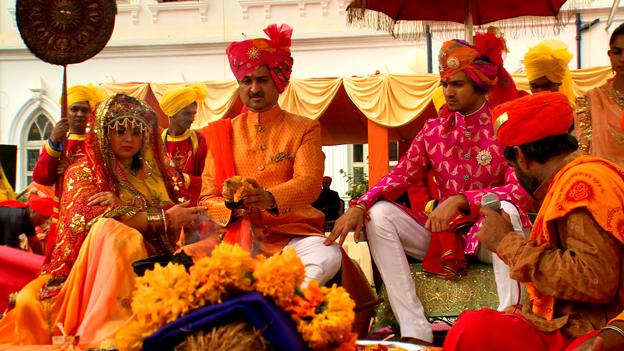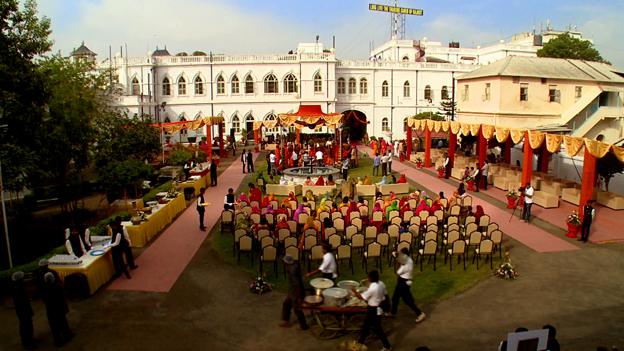The lavish lifestyle of India's royalty
- Published

India's royalty lost their official powers when the nation gained independence in 1947 but the modern-day maharajas are still wealthy and influential - what's more they still know how to arrange a lavish, fairytale wedding.
One doesn't bother about the cost in matters like this, the groom's father tells me.
And as I look around at elephants in gold headdresses and camels adorned with intricate embroidery, he seems true to his word.
Weddings are extravagant social events in India - you're expected to stretch resources to put on a grand spectacle. This one, between Prince Jaideep Jadeja and Princess Shivatmika Kumar, is the first royal wedding I've been to and it gives a new meaning to the term "spectacle".
Possibly the most opulent wedding in the history of independent India, it's certainly an overwhelming scene. And this isn't even the marriage ceremony yet.
Guests spend a whole week before the actual wedding in the town of Rajkot, the historical family home of 23-year-old groom Jaideep Jadeja, son of Prince Mandhata Sinh Jadeja of Rajkot in the former princely state of Saurashtra, in Gujarat.


His 25-year-old bride Shivatmika Kumar, the princess of the former princely state of Dungarpur, in Rajasthan, won't even be in the same state until they both meet in Bangalore thousands of kilometres away.
Rajkot is a sleepy town of nearly 1.3 million residents but it comes alive for these seven days. The main attraction is a grand 8km procession - 5,000 people, including 30 princes in their regal attire, walk alongside the camels and elephants, one of which carries the groom in a golden throne.


Bands belt out popular Bollywood tunes as an ocean of onlookers line the streets and watch from rooftops, trees and stairways. A human chain protects the privileged from being mobbed by well-wishers.
It could be a scene straight out of a film - the glitter, the excitement, the crowds all seem surreal.
Then there's the magnificently decorated Ranjit Villa, the 100-room home of the royal family of Rajkot which was built in 1870. And this party appeared to be on the house.

But in the midst of all this grandeur there are stark divisions. Here are the rich and famous in expensive clothes and jewellery, watched in part-awe and part-adulation by throngs of people, many of whom do not even earn 50 cents a day.
I ask a few of them what they think of this display of luxury and wealth.
"I love all this. They look so beautiful," says 16-year-old Geeta. "I like the royalty because it's a part of our tradition but I would not like to marry one.
"I would not be able to eat at the street vends and ride my scooty [scooter]," she says.
One elderly lady says that it would be great to have the kings back in power, while another shoots back, "No, We love our democracy."

The groom's father seems comfortable with all the expenditure, explaining that the family have tried to include every section of society in the celebration.
Prince Mandhata Sinh Jadeja adds that his family contributes to the local community in many ways. In the week leading up to the procession, they helped feed about 17,000 people in Rajkot, as well as visiting orphanages and hospitals. The family is sponsoring the poor and the needy by helping the organisations that work for them, he says.
But is this enough? Many Indians make the lists of global billionaires and it could be argued that the rich of India should do more for the country's poor.
The groom's father agrees, and says that rich people have a responsibility towards the poor. "In order to connect with the people, in order to respect the fact that we've been born in this house, we should serve the people one way or another," he says.
After a week of traditional festivities in Rajkot, more than 600 guests fly thousands of kilometres south to Bangalore, the home city of the bride's mother. The wedding venue is the magnificent Bangalore Palace, modelled on Windsor Castle, one of the official residences of Queen Elizabeth II.

The party here is as opulent as the one in Rajkot - a luxuriously classy affair but this time it is a private gathering of members of the former royalty.
Like many of India's royals, this family has done well for itself in business - it has invested in hydropower, mining, bio-fuel and other sectors. It had enough spare cash (more than $500,000, £330,000) to buy back the Star of India Rolls Royce - a car it had once owned but sold 40 years ago.
Twenty-two-year-old Yaduveer Krishnadatta, the recently crowned king of the former princely state of Mysore, studied in the US, but returned to continue his family tradition and business. He will also soon marry a girl selected for him by his family - a princess.
When I ask this very shy and quiet young man with diamond-studded headgear if he could marry a commoner, he rejects the idea. It's a duty to preserve the tradition, he tells me.
The groom, whose marriage we are celebrating, Jaideep Jadeja smiles at my question. "The main reason why people like us marry in royal families only [is] because for normal people it's very difficult to cope with the restrictions there are in the house," he says.

In fact, I'm unable to find anyone here who has married outside royal families, or anyone who'd like to.
Perhaps it really isn't easy to live a life that's still etched in the past. Over the course of the wedding I've seen hundreds of men and women from royal families - all of them are educated, most study abroad but invariably they are all still tied to their old ways of thinking.
The bride, Shivatmika Kumar, has a degree in psychology and was brought up in the city of Bangalore. She will work in the family hotel business and wants to start an NGO to improve animal welfare - although many of the women in these families stay at home and don't have jobs.

When I meet her just before the wedding, she's sitting covered from head to toe in red. She's not willing to lift her veil to show me her whole face. It's not allowed according to tradition, she says.
Eventually she does lift her veil slightly, saying that she's not troubled by giving up her big city life in Bangalore for the much smaller, quieter Rajkot.
"I've always left everything to my parents so whatever they decide. They've made the right decisions so far, so I'm sure this one will be right as well."

And until this point she's only briefly met the groom. "We didn't speak much but we both made a good first impression and we both liked each other. And our families liked each other a lot."
But it's just as well that the groom is a dog-lover. "It was the only criteria I had," she says.
The wedding is over in a few hours. The young bride leaves with her new husband for Rajkot and more festivities.
I realise that the Maharajas are going through what India as a nation is going through - walking a tight rope trying to balance modernity and traditional values. I also realise that princes and princesses are not just the protagonists of my daughter's storybooks - for a moment I stepped into a world where the fairytale and reality meet.

India's royalty

A 19th Century maharaja hunting in Punjab
Few monarchies can match the opulence of India's royal courts in their heyday. After Mughal power collapsed in 1739, a new breed of maharajas - mostly comprising prominent Hindu families who had not been killed by the fleeing conquerors - sprang up all over India to replace them.
Many controlled vast tracts of land from their splendid palaces - they owned luxurious cars and some of the world's finest jewellery. Their golden period was from the beginning of the 18th Century to the mid-20th Century.
The Raj essentially operated as a two-tier system - the British had direct control over three-fifths of the subcontinent, known as "British India", and indirect control over the remaining territory - much of which was run by the maharajas.
Under the British, Indian rulers were expected to protect their subjects, adjudicate in disputes and minister justice and punishment. But just as Indian rulers fully adapted to the new imperial regime, they had to change again when India became a republic after independence in 1947.


Watch Rupa Jha's full documentary A Royal Wedding: Indian Style at 04:30 GMT and 21:30 GMT on BBC News, at 05:30 GMT and 11:30 GMT on BBC World News, or you can find it online soon after.
For more from the BBC's A Richer World, go to www.bbc.com/richerworld - or join the discussion on Twitter #BBCRicherWorld, external.